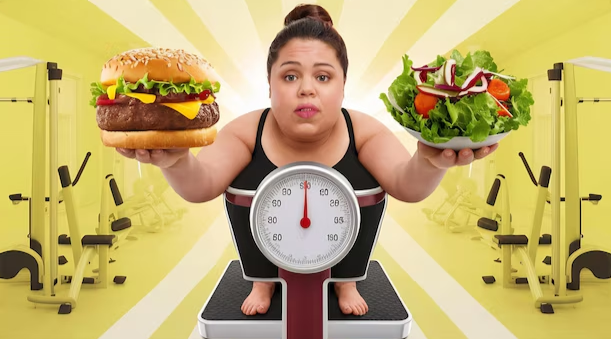It’s a scenario many women are frustratingly familiar with: you and your male partner embark on a weight loss journey together, following the same diet and exercise plan. Yet, the pounds seem to melt off him effortlessly while your progress on the scale is painstakingly slow. This isn’t just in your head. The biological and physiological cards are, in many ways, stacked against women when it comes to rapid weight loss. This article delves into the scientific reasons why it can be more challenging for women to shed weight quickly, exploring everything from hormonal fluctuations to metabolic differences and societal pressures.
The Biological Blueprint: It’s in Our DNA
From an evolutionary perspective, the female body is designed for childbearing and nurturing. This fundamental difference in biology dictates how women store and lose fat compared to men.
Body Composition: Women naturally have a higher percentage of body fat and less muscle mass than men. Muscle is more metabolically active than fat, meaning it burns more calories even at rest. With a higher muscle-to-fat ratio, men have a built-in metabolic advantage.
Fat Storage: Where you store fat also plays a crucial role. Men tend to accumulate visceral fat, which is located around the internal organs in the abdominal cavity. While metabolically active and easier to lose, high levels of visceral fat are also linked to a greater risk of heart disease and type 2 diabetes.
Women, on the other hand, are more prone to storing subcutaneous fat, which lies just beneath the skin, particularly in the hips, thighs, and buttocks. This type of fat is less metabolically active and notoriously more stubborn to lose.
The Hormonal Rollercoaster
A woman’s life is a symphony of hormonal fluctuations, and these natural cycles can significantly impact weight management.

The Menstrual Cycle: Throughout the month, the ebb and flow of estrogen and progesterone can influence appetite, cravings, and water retention. Many women experience increased cravings for high-calorie foods in the days leading up to their period, making it a challenging time to stick to a strict eating plan.
Pregnancy and Motherhood: The significant hormonal shifts during and after pregnancy are designed to support the baby’s growth and prepare for breastfeeding. This often leads to increased fat storage. The demands of motherhood, including lack of sleep and altered routines, can further complicate postpartum weight loss efforts.
Menopause: As women approach menopause, estrogen levels decline, leading to a decrease in muscle mass and a slower metabolism. This hormonal shift also encourages fat storage around the abdomen, a pattern more typical in men.
Hormonal Conditions: Certain health conditions that are more prevalent in women can also make weight loss a significant challenge. Polycystic Ovary Syndrome (PCOS) and hypothyroidism are two common examples that can disrupt metabolism and lead to weight gain. In contrast, men have higher levels of testosterone, a hormone that plays a key role in building muscle and burning fat.
The Metabolic Equation

At its core, weight loss is about creating a calorie deficit. However, the rate at which you burn those calories—your metabolic rate—is influenced by your sex. Due to their higher muscle mass, men generally have a higher resting metabolic rate (RMR) than women. This means they burn more calories throughout the day, even when they’re not exercising. Studies have shown that when men and women are put on the same calorie-restricted diet, men tend to lose more weight, particularly in the initial stages. While this gap may narrow over time, it can be a source of immense frustration for women.
The Societal and Psychological Pressures
Beyond the biological factors, women often face a unique set of societal and psychological hurdles when it comes to weight loss.
Emotional Eating: Research suggests that women may be more prone to emotional eating, turning to food for comfort in response to stress, anxiety, or sadness.
Body Image and Unrealistic Expectations: Women are often bombarded with images of “perfect” bodies in the media, leading to unrealistic expectations and a negative body image. This can create a cycle of restrictive dieting and overeating.
What’s a Woman to Do?
While the challenges are real, they are not insurmountable. Understanding the factors at play is the first step towards a more effective and compassionate approach to weight loss. Here are some strategies that can help:
- Focus on Strength Training: Building muscle is key to boosting your metabolism. Incorporate regular strength training exercises into your routine.
- Prioritize Protein: A diet rich in protein can help you feel fuller for longer and support muscle growth and repair.
- Get Enough Sleep: Lack of sleep can disrupt hormones that regulate appetite. Aim for 7-9 hours of quality sleep per night.
- Manage Stress: Find healthy ways to cope with stress, such as yoga, meditation, or spending time in nature.
- Be Patient and Consistent: Sustainable weight loss is a marathon, not a sprint. Focus on making long-term lifestyle changes rather than seeking quick fixes.
- Seek Professional Guidance: If you’re struggling to lose weight despite your best efforts, consider consulting a registered dietitian or a healthcare professional to rule out any underlying medical conditions.
In conclusion, the journey to weight loss is often a more complex and nuanced process for women. By acknowledging the unique biological, hormonal, and societal factors at play, women can adopt a more informed, patient, and ultimately more successful approach to achieving their health and wellness goals. Remember, the goal is not just to lose weight fast, but to build a healthier and more sustainable lifestyle for the long term



